I left Kingman just before 8am, and an electronic display by a store indicated it was already 98 deg. F. I couldn't bear to think what it would be like at Hoover Dam which was at a lower elevation.
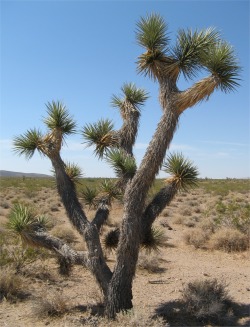 Joshua Tree |
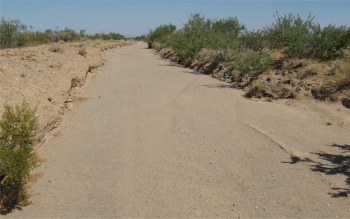 Dried Up River Bed |
I found the historic part of the White Hills story dated back to 1899. Then there was a small community of miners and prospectors working a fairly profitable silver mine. Sadly a flash flood totally destroyed the community, and now there was nothing left to indicate the community ever existed.
I wound my way back down from the hills and across the plain and onto Route 93 again, and continued my journey to Hoover Dam. Within five miles of the dam the approach was full of roadworks, and it was clear that another road was being built up to the dam. I rounded a bend and there it was below me. It was not the earth shattering sight that I had expected, it seemed quite small in width, but I was to learn later that a narrow part of Black Canyon was chosen to minimise the amount of concrete required.
 White Hills Letterboxes |
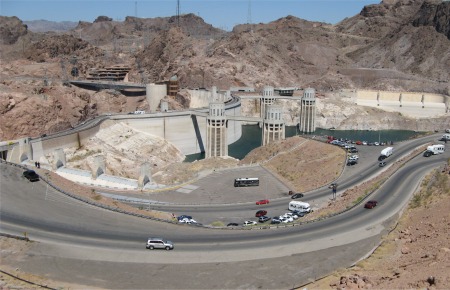 First Sighting of Hoover Dam |
I decided to take the dam tour, and checked in through security, before being allowed to purchase a ticket. At the ticket desk the lady advised that I would have to wait 90 mins. for the next available tour, and she gave me a flimsy plastic helmet, that was neither use nor ornament, apart from indications to tour guides as to who was doing the full tour as opposed to just the turbine hall tour. I looked at it, and told the lady about a sport in England called cricket, where the batsmen put similar shaped items down the front of their trousers as protection. "Do they need them that big?", she joked. "Oh yes", I replied ,"in England they do". We both laughed. The humour got worse when a girl checking tickets asked to see my dam ticket. Work it out.
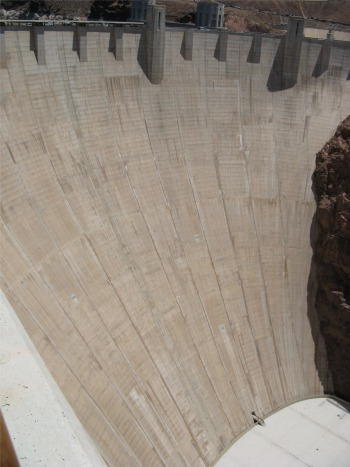 Dam Wall - The Small Opening a Third of the Way Up and One Fifth the Way Across was the Ventilation Opening Where I Peered Out From |
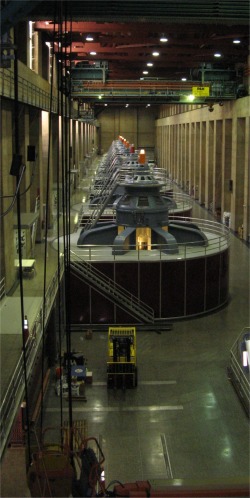 Nevada Turbine Hall |
The rest of the tour took us through tunnels within the dam structure, all following the natural curvature of the dam. We even came across the "stairway to heaven", an impressive flight of stairs that not only followed the curvature of the dam, but also went from the bottom to the top of the dam. The maze of tunnels needed ventilation, and our guide took us down a horizontal ventilation shaft that terminated in the dam wall, from which we got an impressive sight.
Some of the cracks in the tunnel walls had been marked as far back as the 40s, and every five years or so they would be checked to see if they had got worse. One interesting feature was the dam construction. It had been built as a series of interlocking concrete blocks. As with Glen Canyon dam, refrigerated water had been passed through steel pipes within the concrete to keep the concrete cool when setting (concrete gives off heat as it sets). This helped to prevent cracks developing. It had been calculated that if the whole dam had been cast as one huge single block of concrete, it would have taken 125 years to cool down. The dam was not linked or bound in any way to the bedrock or canyon walls. It just rested under its own weight, and the force of the water kept the sides pressed against the canyon walls. By decoupling its integrity from its surroundings, it was much less susceptible to earthquakes, and it was estimated to withstand an earthquake of a magnitude greater than eight on the Richter scale.
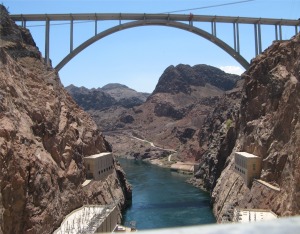 New Bridge Over Black Canyon from Ventilation Tunnel |
I returned to my van in sweltering heat, taking care not to touch any metalwork or stoneware; they were unbearably hot. It was 117 deg. F in the dam vicinity.
I touch the 93 in the direction of Las Vegas, and turned off to take the scenic road around Lake Mead, formed by the Hoover Dam, and the largest man-made lake in America. The Lake Mead National Recreation Area was a startling contrast of desert and water, mountains and canyons, primitive backcountry and modern technology. I found a campsite, sorted out a pitch, and immediately went for a swim in the lake. The water was like bathwater, but refreshing all the same.
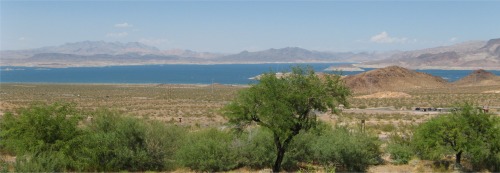 Lake Mead |
